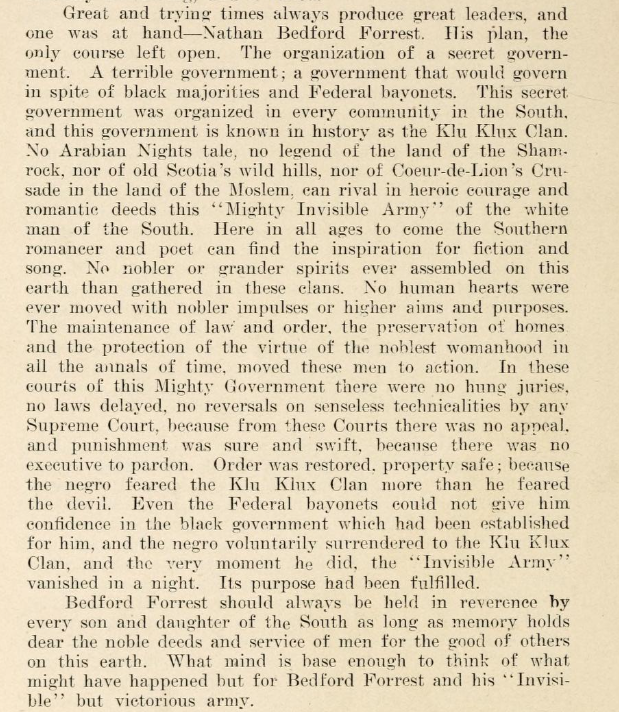Echoes of Reconstruction: Sons of Confederate Veterans Tribute to Gen. Nathan Bedford Forrest
Emerging Civil War is pleased to welcome back Patrick Young, author of The Reconstruction Era blog.

The 1909 Convention of the United Confederate Veterans was held in Memphis, Tenn. between June 8 and June 10. The annual conventions of the premier Confederate veterans organization brought together men from around the country who had fought on behalf of the “Lost Cause” during the Civil War. A whole variety of related-groups also attended and sometimes spoke at the meetings. These included the Daughters of the Confederacy, various Confederate memorial and monument associations, and the Sons of Confederate Veterans. As the old veterans died off, the Sons took on a more important role and often addressed the conventions.
At the 1909 UCV Convention, the address to the veterans from the Sons of Confederate Veterans was delivered by Thomas H. Sisson. Sisson was a son of a veteran of Nathan Bedford Forrest’s cavalry force. While his speech focused on the justness of the Confederate cause, Sisson did give a two page long laudation of Forrest as the man behind the Ku Klux Klan. According to Sisson:
Great and trying times always produce great leaders, and one was at hand—Nathan Bedford Forrest. His plan, the only course left open. The organization of a secret government. A terrible government; a government that would govern in spite of black majorities and Federal bayonets. This secret government was organized in every community in the South, and this government is known in history as the Klu Klux Clan [sic]… Here in all ages to come the Southern romancer and poet can find the inspiration for fiction and song. No nobler or grander spirits ever assembled on this earth than gathered in these clans. No human hearts were ever moved with nobler impulses or higher aims and purposes…Order was restored, property safe; because the negro feared the Klu Klux Clan more than he feared the devil. Even the Federal bayonets could not give him confidence in the black government which had been established for him, and the negro voluntarily surrendered to the Klu Klux Clan, and the very moment he did, the “Invisible Army” vanished in a night. Its purpose had been fulfilled. Bedford Forrest should always be held in reverence by every son and daughter of the South as long as memory holds dear the noble deeds and service of men for the good of others on this earth. What mind is base enough to think of what might have happened but for Bedford Forrest and his “Invisible” but victorious army.
Here is the unedited version of the speech by Sisson, which deploys many racist assumptions, as it appears in the official Proceedings of the Nineteenth Annual Meeting and Reunion of the United Confederate Veterans Held at Memphis:
Screenshot appears below:
The edited version appears in Clint Smith’s book How the Word Is Passed: A Reckoning With the History of Slavery Across America published by Little, Brown and Company (2021)

I recently finished “A fever in the heartland” about the kkk in the Midwest. The new klan focused on hating immigrants Catholics and Jews, as well as enforcing Jim Crow was both frightening and popular winning national goals vs immigration
Good book. Read it when it came out and it is accessible to anyone wanting to read about the “Second Klan.’
I was trying to respond to your thread concerning your concluding chapter on Robert Gould Shaw and your Three Martyrs theme in search of a Union Civil War figure whose name familiarity with the general public rivaled or exceeded that of Lincoln, Shaw and another notable who didn’t survive the war. My attempt to write a comment was short circuited by my paid subscriber status, or lack thereof, so I won’t be addressing Nathan Bedford Forrest and his connection to the Klan. But a name did occur to me. Arthur MacArthur Jr. was at Missionary Ridge in 1863 at the not yet ripe age of 18 when he seized the regimental flag of the 24th Wisconsin from a fallen soldier and bore it to the top of the ridge, under withering fire and against orders, where he planted it, an act for which he retroactively received the Congressional Medal of Honor on his own orders. He probably would have died that day if Union forces hadn’t also been attacking both ends of the ridge so that Confederate troops along the well fortified central slope were withdrawn to prevent being besieged on all sides except the opposite slope where retreat was still an option. Thirty five years later Arthur MacArthur Jr. was still in a uniform and was put ashore at Fort Santiago in Manila’s Intramuros with about a hundred troops while Admiral Dewey in about two hours sank the wooden ships in Manila Bay that the Spanish had once called a Navy. The Spanish weren’t real pleased to see him. Nor were Aguinaldo’s ragtag Filipino Independence forces who saw the American fleet’s arrival as a great opportunity to square off with the Spanish. Douglas MacArthur was eighteen years old in 1898 and packing his bags in New Mexico on his way to West Point. When Arthur MacArthur Jr. retired in 1910 he was sixty-five years old and the only service member in the U.S. military who had actually participated as a combat veteran of the American Civil War. He died of a stroke he suffered while addressing the surviving soldiers of the 24th Wisconsin at their 50th Reunion in Milwaukee. Old soldiers never die ….